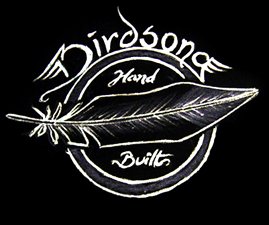It was the late ‘90s when I first used the Birdsong name, about 2000 when it first showed up on a headstock (woodburned, naturally), and 2004 when we became an actual little company with workshop, tools, website, and a phone. The stuff I built in the ‘90s (most of it signed “Scott” on the headstock, which I’d do again years later on the Shortbass) was odd to say the least; the early Birdsong pre-company stuff as well. It was mostly experimenting – some get into this life by making Stratocaster copies, I wanted to know what the twang of a double rail DiMarzio wired coils parallel in the bridge position of a short scale guitar with a solid mahogany body sounded like vs., say, the twang of a Tele.
Ultimately, like any line cook that turns chef, it’s with recipes. Ingredients that always work together for you, special seasonings you come up with, different techniques that bring out different results… you piece all this gathered through experience together as your skills get honed, and then you have signature menu items. The Cortobass was launched in 2004 and built the little company we built to build IT. Today’s Cortobass is about the same as the ones from 14 years ago… perhaps a bit more refined, but the basic specs are the same. Low-noise single by the neck for woody bluesy jazzy warmth with no mud, small humbucker back closer to the bridge for punch, power & clarity but not TOO big. Both together? THE big tone nobody ever expected out of a small, short scale bass. HUGE. Mahogany body, maple neck, rosewood board.
At the time, the prototypes of what would evolve into the Cortobass were just my next ideas, solutions or questions built into the next little bass. Here is a Cortobass and four prototypes. You can see where it came from. You can also see what I was getting at visually, and how that evolved. Various bits of design or wood combo or info from each became combined into a whole & refined into what became the basis of the basses of Birdsong. All other models are based on leaning THIS recipe further in one direction or another visually or tonally. The basic Cortobass is our calibration; our unit of measure; the north star we navigate bass design by.
The first was a short scale in 1998 which was a starting point ergonomically and tonally. The second is the Dragonfly, which came together in 1999-early 2000, giving some overall dimensions and the neck pickup, and an early version of the control plate shape. The third, shown in its later "guitar" reconfiguration, was actually when mahogany/maple/rosewood was settled on as standard, and it was in this bass the bridge pickup and position were decided on. Fourth, we have Cortobass #001 where it all came together, and then the refined design.
This is more than guitar or bass design, it’s life – we walk and experience and if we allow ourselves to spend most of our attention working with the lessons and constructive bits we come out of our situations with as we go, we build new and better things – lives, relationships, selves – out of the pieces that worked and what works together to season our lives and doings. Wallow in what didn’t work and that’s where you stay. Try to force it all into fitting some other shape or how you wanted it to be BEFORE all that you know now, and you don’t get the garden that wanted to grow for you maybe just a little to the side of that. I’ve watched people not go with what it all shapes up as, instead disrupting it by insisting on banging their head against this other thing over here that was the role they cast themselves in. And it fails because in trying to force the other into happening they work against what IS HAPPENING right now in front of them, already forming, already shaping up and trying to hone THEM into its captain. All they really failed at was getting out of the way. Brethren, in this life, if through gathered experience and discoveries it hands you two in one hand and two in the other that you can add together and somehow come up with 5, there’s your magic – there’s your recipe – go with it. A bass may be just wood and wire, but this bass added up to 5 – had that extra something all combined – and that got the interest, and that impressed owners enough to talk, and that built the company, and that’s why we’re here talking now. Note what worked and keep walking and when the groove takes over, that’s your song. Let the others go - they led to this.
Listening to: Joe Henderson So Near, So Far (Musings For Miles) – with Scofield, Dave Holland and Al Foster on drums, just sweet from first note to last. An excellent, excellent jazz album. And Dungen Tio Batir, and the Stones Beggars Banquet.






